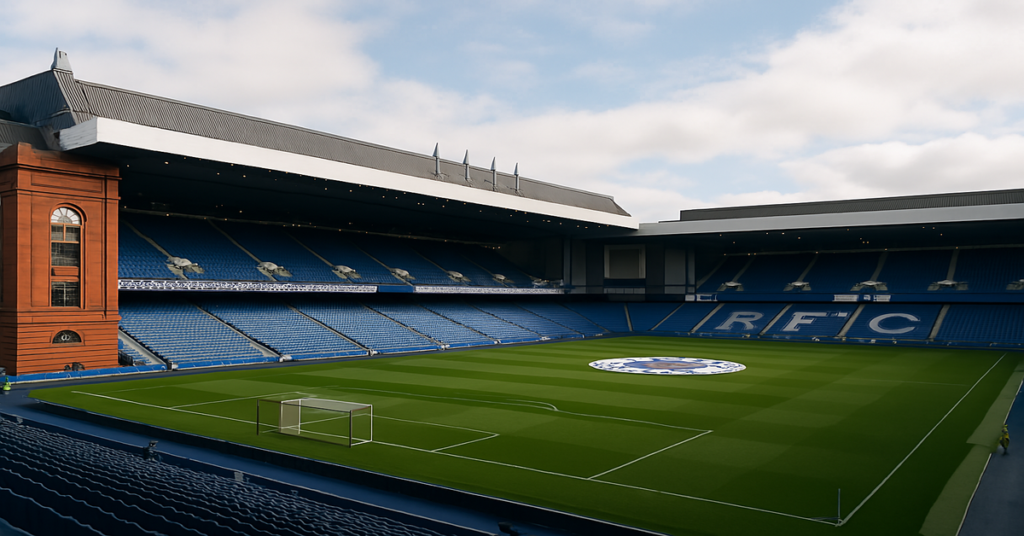Ibrox Stadium stands as one of the most iconic and historic football stadiums in the world. Located in the Govan district of Glasgow, Scotland, Ibrox is the home of Rangers Football Club, one of the most successful and storied clubs in British football history. More than just a football venue, Ibrox is a symbol of tradition, pride, and community for millions of supporters around the globe.
From its early beginnings in the late 19th century to its modern-day status as a UEFA Category Four stadium, Ibrox has undergone numerous transformations. With a rich tapestry of triumphs, tragedies, architectural innovations, and fan culture, Ibrox remains a central figure in the landscape of Scottish and international football.
History of Ibrox Stadium
Origins and Early Years
The roots of Ibrox date back to 1899 when it officially opened as the third stadium to bear the name “Ibrox.” The first two grounds, both relatively modest, were outgrown quickly as Rangers FC’s popularity surged. The third Ibrox, built with a capacity of over 40,000, marked a significant step forward for the club and the Scottish game.
At that time, the stadium featured an oval-shaped design with a running track and vast terraced banks. Football grounds in that era often prioritized sheer capacity over comfort or safety, and Ibrox was no different.
The 1902 Disaster
On April 5, 1902, tragedy struck during a Scotland vs. England match. A section of the wooden terracing on the West Tribune Stand collapsed due to structural failure, leading to the deaths of 25 spectators and injuring over 500 more. This disaster prompted a major shift in stadium design and safety protocols, not just at Ibrox but across Britain.
Mid-20th Century Developments
By the 1920s and 1930s, Ibrox saw several expansions under the direction of renowned stadium architect Archibald Leitch. Leitch’s signature features, such as the red-brick façade and distinctive gabled roofs, helped define Ibrox’s classic appearance.
The Main Stand, completed in 1929, is still in use today and has been designated a Category B listed building for its architectural and historic importance.
The 1971 Ibrox Disaster
On January 2, 1971, another tragedy struck when 66 fans lost their lives in a crush on Stairway 13 at the end of an Old Firm match against Celtic. The disaster led to a comprehensive review of the stadium’s infrastructure and crowd management, spurring renovations to improve safety.
This marked a turning point in football stadium safety, with Ibrox becoming a leading example of how to modernize older grounds without erasing their legacy.
Modern Ibrox Stadium
Renovations and Redesign (1970s–1990s)
In the wake of the 1971 disaster, Rangers undertook a complete overhaul of Ibrox. Led by then-manager Willie Waddell, the redevelopment plan aimed to make Ibrox one of the safest and most modern stadiums in Europe.
The new Ibrox design included the removal of terracing, the construction of new stands, and the introduction of all-seater arrangements — a groundbreaking concept in the UK at the time.
By the 1990s, Ibrox was virtually unrecognizable from its original layout. The fully seated, four-stand configuration increased comfort and safety while maintaining the cauldron-like atmosphere for which the stadium was known.
Current Capacity and Facilities
Today, Ibrox has a capacity of approximately 50,817 seats. It consists of four main stands:
- The Bill Struth Main Stand – the oldest and most historic section, containing executive boxes, media facilities, and club offices.
- The Broomloan Stand – traditionally allocated to away fans during Old Firm derbies.
- The Copland Road Stand – home to some of the most vocal Rangers supporters.
- The Govan Stand – connects the Main Stand with both end stands and includes a large video screen.
The stadium is equipped with modern facilities, including hospitality suites, lounges, fan zones, and advanced security and monitoring systems. Ibrox also features a club megastore, museum, and conference/event spaces.
Cultural Significance
Home of Rangers FC
Ibrox is more than just a stadium; it is the heart of Rangers Football Club. For generations of supporters, it represents loyalty, identity, and belonging. The passion of the home crowd, especially during major fixtures like the Old Firm, creates an electric atmosphere that is renowned across Europe.
Symbol of Glasgow’s Working-Class Heritage
Ibrox stands as a proud symbol of Glasgow’s industrial past and working-class roots. For decades, the stadium served as a weekly escape for workers, where football provided a sense of hope, pride, and collective experience.
Impact on Scottish Football
As one of the largest and best-equipped stadiums in Scotland, Ibrox has hosted numerous high-profile events, including:
- Scottish Cup semi-finals
- International friendlies
- UEFA competition matches
- Youth tournaments
Its influence on the development of stadium infrastructure in Scotland is immense, setting a benchmark for safety and modern amenities.
Architectural Highlights
Archibald Leitch’s Legacy
The red-brick Main Stand, with its Edwardian design and ornamental façade, is a testament to the vision of Archibald Leitch. This stand, built in 1929, remains one of the finest examples of early 20th-century football architecture.
UEFA Category Four Status
Ibrox is classified as a UEFA Category Four stadium, the highest rating available. This allows it to host top-tier European competition, including Champions League and Europa League matches.
Technological Advancements
The stadium is equipped with state-of-the-art lighting, PA systems, high-definition LED screens, and advanced pitch maintenance technology, including under-soil heating. The combination of heritage and innovation makes Ibrox unique.
Notable Events at Ibrox
Memorable Matches
Ibrox has been the venue for some of the most unforgettable moments in Rangers’ history, including:
- Rangers 3-2 Dynamo Moscow (1972) – European Cup Winners’ Cup semi-final
- Rangers 5-1 Celtic (1983) – A dominant Old Firm win
- Rangers 1-0 Parma (1999) – Champions League qualification match
Concerts and Non-Football Events
Over the years, Ibrox has hosted major concerts and events, including performances by artists such as:
- Elton John
- Rod Stewart
- Bon Jovi
These events showcase Ibrox’s versatility and importance as a cultural venue in Glasgow.
The Ibrox Matchday Experience
Arrival and Atmosphere
Matchdays at Ibrox are a spectacle. Fans begin gathering hours before kickoff, filling nearby pubs, singing club anthems, and creating an unforgettable buzz. The sight of thousands marching toward the stadium in blue is an experience in itself.
Fan Engagement
The club has worked hard to enhance the fan experience with initiatives such as:
- Pre-match fan zones
- Food and beverage stalls
- Live music and entertainment
- Kids’ activities and interactive zones
Accessibility and Transport
Ibrox is easily accessible via Glasgow’s public transport network, particularly the Ibrox subway station on the Glasgow Subway system. It also features accessible entrances and facilities for disabled supporters.
Tragedy and Tribute
The Memorial to the Victims
Outside the Main Stand, a touching memorial commemorates the victims of the 1902 and 1971 disasters. Each year, fans gather to pay their respects, ensuring that the lives lost are never forgotten.
Legacy of Safety and Reform
The Ibrox disasters were catalysts for sweeping changes in stadium safety. The legacy of those events lives on not only in the rebuilt Ibrox but also in the standards now enforced across all major football venues in the UK.
Looking to the Future
Expansion Plans
There have been discussions in recent years about increasing Ibrox’s capacity and further modernizing its facilities. These include proposals for:
- A new multi-purpose facility
- Expanded hospitality suites
- Green energy integrations
- Improved digital infrastructure
Role in Community Development
Rangers FC has embraced its responsibility as a community institution. The stadium regularly hosts charity events, educational programs, and outreach initiatives aimed at uplifting the local community.
Conclusion
Ibrox Stadium is not just a venue; it is a living monument to the passion, perseverance, and pride of Scottish football. Its story is one of innovation shaped by tragedy, resilience fueled by history, and community spirit reflected in the sea of blue that fills its stands week after week.
From its architectural beauty to its electric matchday atmosphere, Ibrox remains a revered landmark — not only for Rangers supporters but for football lovers around the world. As the club continues to evolve, one thing is certain: the legacy of Ibrox Stadium will endure for generations to come.
FAQs
1. What is the capacity of Ibrox Stadium?
Ibrox Stadium currently has a seating capacity of approximately 50,817.
2. When was Ibrox Stadium built?
The current Ibrox Stadium officially opened in 1899, though it has undergone major renovations, especially after 1971.
3. What tragedies occurred at Ibrox?
Two major disasters occurred at Ibrox: the 1902 stand collapse (25 deaths) and the 1971 stairway crush (66 deaths). Both events led to significant safety reforms.
4. Who was Archibald Leitch?
Archibald Leitch was a pioneering stadium architect who designed the iconic Main Stand at Ibrox. His influence shaped many British football grounds in the early 20th century.
5. Can visitors tour Ibrox Stadium?
Yes, Ibrox offers stadium tours that include visits to the dressing rooms, the tunnel, trophy room, and the pitchside area.
6. What is the best way to get to Ibrox Stadium?
The easiest way is via the Glasgow Subway system, with the Ibrox station just a short walk from the stadium. Buses and taxis are also available.







